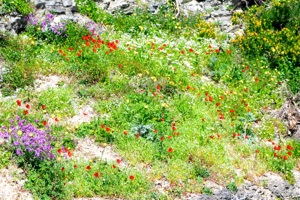The Wild Flowers of Skopelos
Blog
For those who love Skopelos and the wildflowers of Greece
The Wild Flowers of Skopelos
Blog
For those who love Skopelos and the wildflowers of Greece


















Wild berries
26 Nov 2018
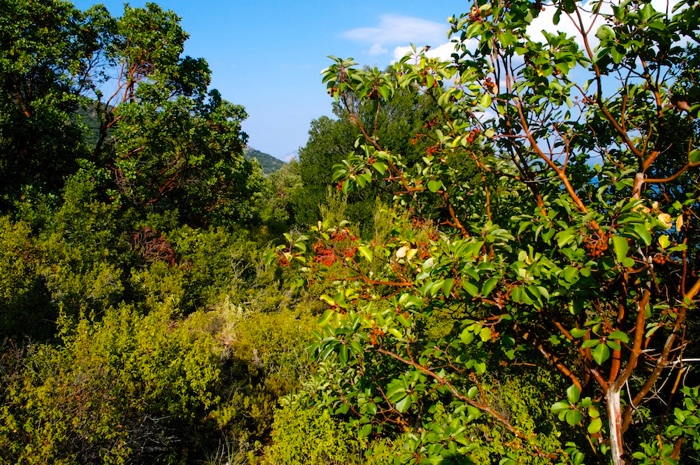
The purpose of flowers is to produce seeds and the purpose of seeds is to perpetuate the species. The seeds are contained in a fruit and for many shrubs the fruits are sweet berries, which entice animals especially birds to help in the distribution of the seeds. Biologically, a berry is a fruit without a stone produced from a single flower with a single ovary. As autumn progresses and deciduous trees and shrubs loose their leaves, the island is brightened by the bright berries in many colours, red, yellow, blue and purple. Many of the culinary fruits called berries are not true berries, but are all small and juicy.
The five new plants added this month are all shrubs whose flowers are followed by colourful berries.





See also:
Click here for more trees of Skopelos.
Remember September.........
4 October 2018
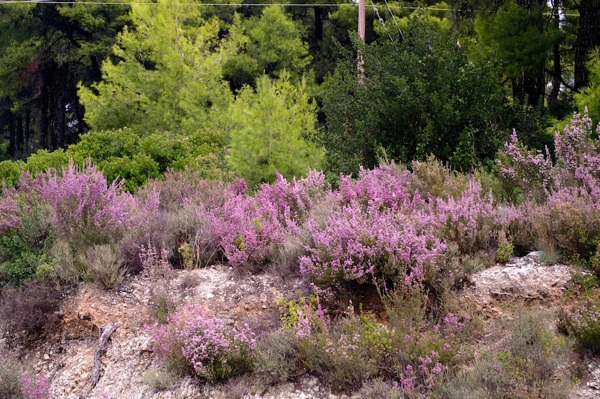
At the end of summer the clouds start to build up and heavy showers and thunder storms occur, the North wind blows bringing cooler temperatures, although there are still more sunny days to come when the silvery light of the afternoon sparkles on the surface of the sea. The island itself seems to breathe a sigh of relief and dark forest trees become a lighter, brighter green, as the pines put out new growth.
In the fields and olive groves and along the roadside the flowers of autumn emerge: it seems like a second spring. First to appear are the delightful pink cyclamen (Cyclamen graecum) on their coiled stems, often seeming to grow from the bare rocks.Next are the beautiful autumn crocus (Colchicum binovae) with purple petals checked with white, contrasting with bright yellow stamens; the bright, shiny, golden (Sternbergia lutea) appear in sunny fields, olive groves and orchards and the elegant spikes of the sea squill (Drimia maritima) grow tall amongst dying thistles. More easily overlook are the small pale purple autumn squill (Prospero autumnalis) and ladies tresses (Spiranthus spiralis) with its tiny white flowers; this is the only orchid to flower in autumn.
Much more noticeable are the frothy heads of the purple heather (Erica manipuliflora) edging the roadsides and footpaths: they provide abundant pollen in the late season for the bees which make the famous Skopelos honey.
Aromatic herbs and shrubs
21 August 2018
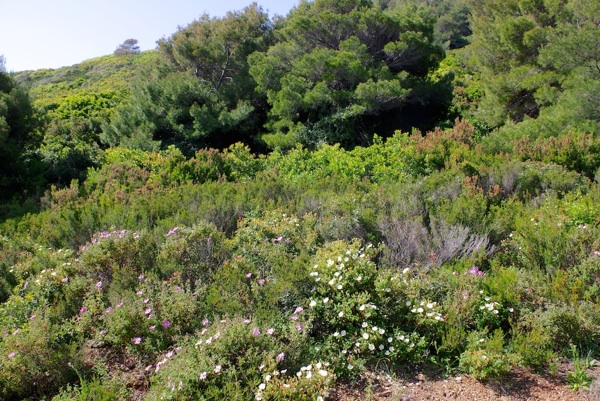
The plants added this month are considered to be typically Mediterranean; they all exhibit features which allow them to exist and thrive in Mediterranean summers. They are able to withstand high temperatures, a paucity of moisture and prolonged exposure to high intensity of light, which would make other plants wilt or die.
They form compact mounds and have small thickened leaves; they are collectively referred to as aromatic sclerophyllous vegetation. The leaves and much of the plants are covered in glandular hairs, giving them a blue-grey appearance and emitting volatile oils, which surround the plant in vapour to reduce water loss protecting against heat and light. The oils are often aromatic, each with a fragrance characteristic of the species, which can be useful in recognising the plants.
These aromatic herbs have been valued for millennia and used medicinally, to flavour foods, wines and teas or to create exotic perfumes.





There are many other aromatics on Skopelos, see also:
Origanum vulgare, Salvia fruticosa, Thymbra capitata & Teucrium polium.
Pyrogenicity
These plants probably evolved before the Mediterranean climate at a time of geological upheaval when fire resulting from volcanic activity or lightening strikes contributed to changes in vegetation. The plants which were able to survive fires were also able to resist hotter drier climatic conditions. The aromatic Mediterranean plants, including Pinus halpensis, the dominant tree species of Skopelos, are adapted to fire and able to regenerate after fire, either by stump resprouting, (arbutus and pistacia species and evergreen oaks) or from seed (P. halpensis and Cistus species).
However fire is a destructive force and these plants are not only adapted to fire but also highly flammable; they are pyrogenic and a single spark can result in large fire of high intensity, causing environmental destruction and species loss. Further degradation may follow when heavy autumn rains, common in the Mediterranean, wash away the exposed soil.
Great care is needed to protect the precious island environment of Skopelos and prevent a recurrence of the recent conflagration which has caused so much damage to Amarandos.

Protect our forest from fire
Beauty and the Beast
17th July 2018
“Pollination is one of the most fascinating aspects of interaction between plants and insects.”1
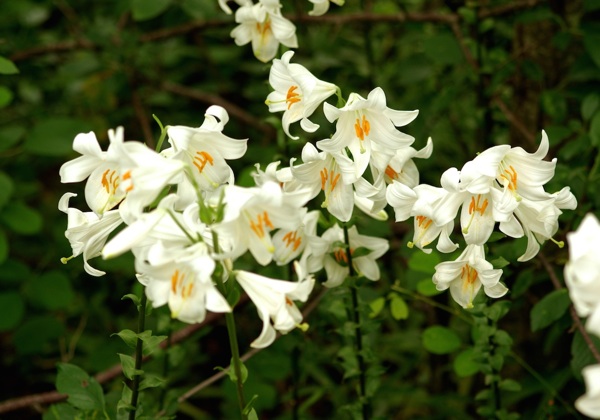
This month only two plants have been added Lilium candidum and Dracunculus vulgaris,
beauty and the beast.
Lilium candidum, because of its pure beauty has become associated with the Virgin Mary and has been given the name madonna lily.In contrast Dracunculus vulgaris, because of its curious dark appearance is associated with dragons, magic and snakes, it is known as the dragon lily. The madonna lily is pollinated by night flying moths attracted by a fragrant perfume and the dragon lily by flies attracted by a foetid smell.
Only the madonna lily is a true lily, the dragon lily is from the arum family; both flower in early summer.
1. H Y Mohan, Ram Gita Mathur. Flower - insect interaction in pollination. Proceedings:Animal Science.1984.


Ramblers and scramblers
19th June 2018
“Plants become climbers, in order as it may be presumed, to reach the light,
and to expose a large area of their leaves to its action and to that of the free air.”
CHARLES DARWIN. 1882.
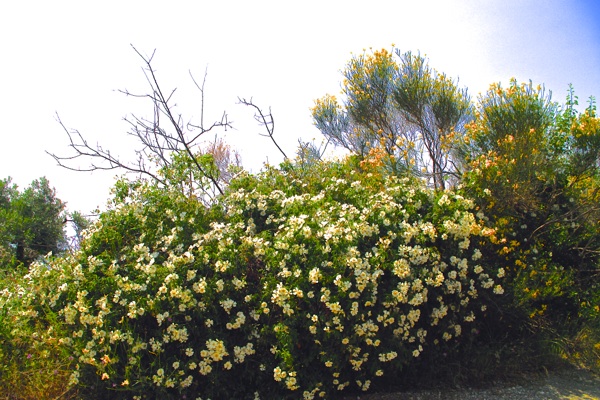
As spring progresses into summer and the brilliantly coloured wildflower scattered across the island begin to fade and die, but a walk along the lanes and narrow footpaths, the monopatia, of Skopelos is brightened by the pale pink and white of the ramblers and scramblers.
There is the beautiful evergreen rose, Rosa sempervirans, with an abundance of pure white blooms and green glossy leave and the simple pale pink dog rose, Rosa canina; the heavily scented Mediterranean clematis, Clematis flammula, with its myriad of creamy-white flowers which twines around wire fences and clambers over neighbouring bushes in full summer sun; the more discrete Clematis vitalba, whcih flowers later and prefers shady places. The brambles, Rubus sanctus and R. canescens, which can be troublesome weeds, at this time of year are covered in pink or white blossom which are followed by tasty blackberries. Possibly the most delightful of all is the honeysuckle, Lonicera implexa, with its twirling stems and pretty tubular flowers with their delicate fragrance and sweet nectar.
Four new plants have been added, all ramblers and scramblers:




Now more than 250 flowers and trees

